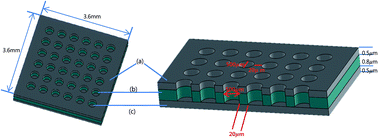A highly sensitive humidity sensor with a novel hole array structure using a polyimide sensing layer
Abstract
If the contact area of water vapor with the sensing part in the humidity sensor is increased, the sensitivity will be increased. In this paper, a new type of capacitive humidity sensor was demonstrated in order to increase the sensitivity of the humidity sensor utilizing MEMS technology. The sensor is composed of a SiO2 insulation layer, a bottom electrode, a polyimide layer with a hole array as a sensing layer and a top electrode with a hole array. The holes in the sensing layer and top electrode are made to increase the contact area of the water vapor with the polyimide sensing layer. The size of the sensor is 3.6 mm × 3.6 mm with a 0.8 μm thick polyimide based sensing layer. In order to obtain the highest sensitivity from the sensor of these dimensions, a simulation was carried out with parameters of different minimum distances between holes, the numbers of hole, and hole diameters. The final sensors were designed, and fabricated based on simulation results. The output of the humidity sensor was found to be linearly dependent on relative humidity in the range 20 to 90% and the sensitivities of the humidity sensors showed values from 14.43 pF per %RH to 22.29 pF per %RH. The maximum hysteresis was 1.08% for a sensor with a sensitivity of 14.43 pF per %RH.


 Please wait while we load your content...
Please wait while we load your content...